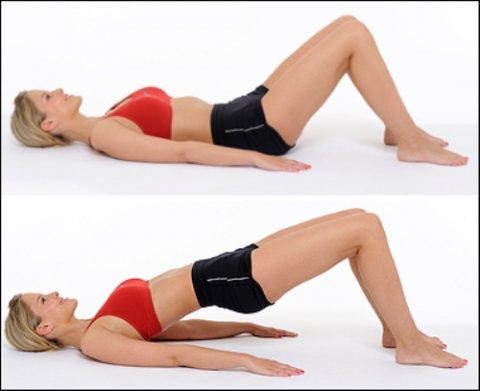Intense abdominal exercises are exercises which involve strong contractions of the rectus abdominis muscles and surrounding abdominal muscles. During intense abdominal exercises, such as sit ups, crunches, and planks, the upper abdominal muscles (the six-pack muscles) generate a large amount of pressure within the abdomen. The muscles surrounding the trunk, such as the external and internal obliques, as well as the transversus abdominis, manage the pressure generated by the rectus abdominal muscles. The pelvic floor muscles withstand the downward pressure generated by the rectus abdominis muscles, which is applied to the pelvic floor.
If the pressure associated with abdominal exercises is too great for the pelvic floor muscles to withstand, then the pelvic floor is forced downwards, causing the pelvic floor muscles to stretch and weaken.
Abdominal exercises that repeatedly force the pelvic floor downwards, or particularly intense core abdominal exercises that completely overload the pelvic floor should be modified to prevent injury to the pelvic floor in women.
12 AB EXERCISES TO AVOID (exercises to avoid are written in RED with a safe alternative in GREEN)
The 12 abdominal exercises listed below should be avoided or modified by women to minimise the risk of pelvic floor strain and injury, particularly women who have had children, women who experience light bladder leakage (LBL) or women who have had prolapse surgery. These intense abdominal core exercises have the potential to overload the pelvic floor in women, especially those with pelvic floor dysfunction:
1. Traditional abdominal curl or sit-up exercises
 |
| Sit-up |
Modification: This exercise can not be modified as all other options still require a large amount of downward force on the pelvic floor. Instead I encourage clients to perform mindful pelvic floor contractions whilst performing a reverse bridge or pelvic lift (below).
 |
| Pelvic lift |
2. Incline sit-ups
 |
| Incline sit-up |
Modification: There is not an appropriate way to modify this exercise. I suggest standing knee raises as an alternative exercise to incline sit-ups. Make sure you perform standing knee raises with an activated core (below). Standing knee raises allow you to work on your balance and strengthen your mid-section, providing you maintain core activation.
 |
| Standing knee raises |
3. Abdominal machines
 |
| Abdominal Machine |
 |
| Abdominal Machine |
Machines designed to work the abdominal muscles should be avoided, especially if your goal is to strength your core without compromising your pelvic floor muscles.
Modification: Usually trainers would recommend sit-ups or abdominal crunch exercises, however we know that these exercises are detrimental to your pelvic floor. I recommend trying reptile planks against a wall (below). TRAINERS TIP: For beginners - do not use a swissball. Place your hands against the wall, similar to the beginning position of a wall push up. For those who are more advanced - perform the reptiles as pictured below, using a swissball.
 |
| Reptiles - advanced option |
4. Oblique sit-ups
 |
| Oblique sit-ups |
Modification: Try performing this exercise standing, as this will reduce the amount of downward pressure on the pelvic floor. Performing this exercises standing will develop balance and stability.
 |
| Standing oblique crunch |
5. Oblique machine
 |
| Oblique machine |
6. Exercise ball sit-ups
 |
| Exercise ball sit-ups |
Modification: Instead of performing exercise ball sit-ups, use the exercise ball to perform walk outs. By maintaining an activated core you will be protecting your pelvic floor from intense downward pressure. Be sure to activate your glutes to assist you on the upward motion of the movement.
 |
| Exercise ball walk outs - starting position |
 |
| Exercise ball walk outs - finish position |
7. Exercise ball leg raises
 |
| Exercise ball leg raises |
8. Bicycle legs
 |
| Bicycle legs |
Modification: To modify this exercise to be pelvic floor safe, perform the exercise with one knee bent and one foot always on the ground.
9. Double leg raise
 |
| Double leg raise |
Modification: Perform this with one leg instead of two.
 |
| Single leg raise |
10. Hanging knee raise
 |
| Hanging knee raise |
11. Pilates “Table Top” or “The Hundred”
 |
| Pilates "Table Top" |
 |
| Pilates "Hundreds" |
 |
| Modified "table top" (These positions can also be used for "hundreds" - but remember to keep your head down on the floor) |
 |
| Supported "table top" and "hundreds" |
12. Intense core “Plank” or “Hover” exercises.
 |
| Intense "Plank" (aka "Hover") |
Full Plank or Hover involves full bodyweight bearing through the forearms and the feet. This is an intense abdominal core muscle exercise.
Modification: The pelvic floor loading associated with full Plank or Hover can be reduced with -
- Kneeling rather than supporting body weight through feet
- Breathing normally and avoid holding your breath
 |
| Plank on knees and forearm |








